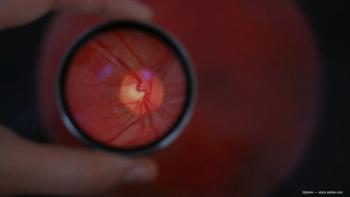
Complicated cataract: A case of iatrogenic zonular disinertion
An approach is described for completing cortex removal and IOL implantation after intraoperative 180° zonular dialysis.
Toronto, CA-When an overly aggressive attempt to remove tenacious cortex results in iatrogenic zonular dialysis, the first priority for the cataract surgeon should be to take steps to maintain capsule integrity and avoid vitreous prolapse. Removal of residual cortex is also important for the final outcome.
Options for management might include cautious endocapsular phacoemulsification by itself, conversion to extracapsular surgery, capsular retractors, implantation of a capsular tension ring (CTR), and use of a sutured capsular tension device.
The decision, however, will be best made through careful assessment of the situation once the eye is stabilized, said Iqbal (“Ike”) Ahmed, MD.
In an intraoperative video, Dr. Ahmed, assistant professor of ophthalmology and vision sciences, University of Toronto, Ontario, Canada, presented his approach to managing this “disinsertion dilemma” in a case involving a 180° zonular dialysis.
The patient did not have pseudoexfoliation or other risk factors for zonular weakness, and the surgery was proceeding uneventfully until cortex removal. As the operating surgeon persisted in trying to remove residual cortex, the capsule was aspirated into the instrument tip, resulting in 180° of nasal zonular dialysis with retained cortex in the capsular bag. Fortunately, the capsular bag remained intact, Dr. Ahmed said.
After stopping the procedure and while keeping the I/A tip in the eye, a cohesive ophthalmic viscosurgical device (OVD) was instilled to reform the anterior chamber and stabilize the eye.
Dr. Ahmed offered several tips for completing this initial step.
“It is important to keep the I/A instrument in place because if the capsule has been aspirated into the tip, removing the hand-piece from the eye could bring the entire capsular bag too,” he said.
The injected OVD can serve to displace any aspirated capsule from the tip, but before OVD is injected, infusion should be stopped or else the injected material will come back out from the incision site. At the same time, surgeons need to be careful not to overfill the eye as that will also cause OVD to leak out of the incision, and vitreous prolapse may follow.
Once the I/A tip was freed of material and the chamber stabilized, examination showed the residual cortex was present primarily in the superior area of the capsular bag, well away from the site of the zonular dialysis.
Considering that use of an automated technique for completing cortex removal could create an unstable situation, Dr. Ahmed chose a manual approach to cortex aspiration, using a 27-gauge hockey-stick cannula to irrigate and aspirate the residual cortex.
“It is important to add a few boluses of irrigation that will not only help with cortex removal but will also keep OVD away from the cannula,” he said.
After completing cortex removal, Dr. Ahmed said he was comfortable in this case placing a CTR to stabilize the capsular bag, taking into account the location of the zonular dialysis, its extent, and anticipating that it was stationary, i.e., non-progressive.
“My limit for using a standard CTR is up to six clock hours of localized zonulysis, assuming the remaining zonules are in good shape. In that setting, the CTR is quite effective in distributing forces around the entire capsular circumference,” he said. “In addition, the dialysis in this eye was 180° away from the incision, which enabled injection of the CTR into the area of weakness. That would have been more difficult if the dialysis was located temporally.”
Dr. Ahmed said he removed cortex first rather than starting with placement of the CTR as the latter sequence could result trapping of cortex behind the ring.
Next, he implanted a one-piece IOL, which he said he favored because its insertion is atraumatic relative to a three-piece implant. OVD was removed manually due to concern about the possibility of bringing vitreous forward using the I/A hand-piece in an automated technique.
“The outcome seemed favorable, although I felt if the lens decentered, I could still go back in the first few months postoperatively to suture the CTR to the sclera and avoid a more extensive secondary procedure in the operating room. Fortunately, the IOL has remained well-centered,” he said.
Ike Ahmed, MD
This article is based on a presentation given by Dr. Ahmed at American Academy of Ophthalmology meeting in 2015.
Dr. Ahmed is a consultant to Abbott Medical Optics, Alcon, and Bausch+Lomb.
Newsletter
Don’t miss out—get Ophthalmology Times updates on the latest clinical advancements and expert interviews, straight to your inbox.









































